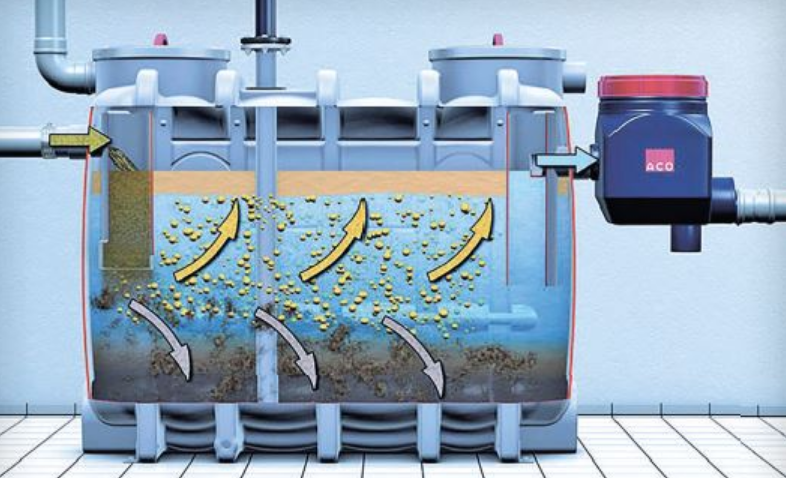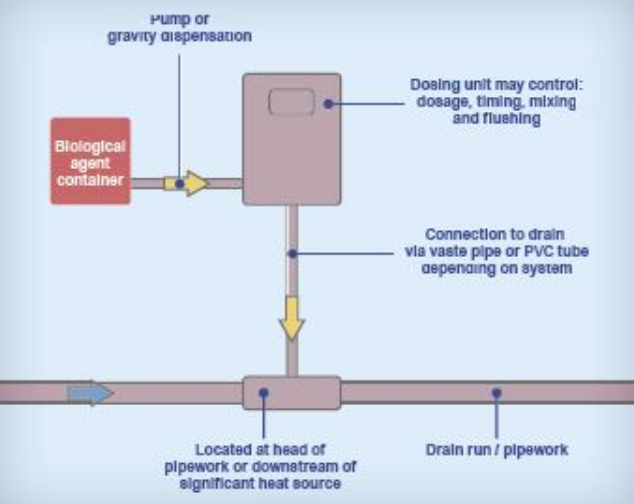Grease management

|
| ACO Gravity Grease Separator (ACO, 2017) |
Dealing with the problems of FOGs (Fats, Oils and Greases) entering our sewer system and measures that can be implemented to change the UK dosing systems to removal systems.
Contents |
[edit] Introduction
The UK experiences 366,000 sewer blockages every year flooding more than 3,000 properties through the accumulation of Fats, Oils and Greases (abbreviated to FOGs), all originating from domestic, commercial or industrial premises (Water UK 2017). This in turn costs the UK approximately £15 million to clear; financed mainly by the utility companies. These costs are then passed on to the consumer in the form of higher bills (CIBSE 2014). Clearly this is a problem that needs to be addressed.
[edit] UK Legislation unable to tackle the problem
The very vague and ineffectual UK regulations and legislation must bear much responsibility. Approved Document H offers little relief in its content stating; “…drainage serving kitchens in commercial hot food premises should be fitted with a grease separator complying with BS EN 1825-1 and designed in accordance with BS EN 1825-2 or other effective means of grease removal”. This has simply encouraged contractors to install dosage systems to push the problem downstream and push the cost on to the utility companies.
[edit] The Solutions: Dosage Versus Grease Separation

|
| Dosing System Components (British Water, 2017) |
One example of a dosage system is shown in the illustration above. It is the preferred method amongst UK contractors and retailers as it is easy to install and retrofit, space is saved and it is the cheapest option to implement. However, as waste water moves down the sewer network, FOGs can still regroup and impede waterflow.
More effective are the grease separation systems exemplified by the ACO Grease Separator (ACO, 2017). FOGs and wastewater are separated within a chamber and the water is cooled sufficiently to allow the FOGs to harden and the wastewater to be pumped away down the discharge sewer pipes devoid of any hardened FOGs. Clearly this is a much more effective system. With an improvement in UK legislation, updated building regulations, establishment of FOG concentrate levels and better enforcement, the £15 million cost of managing FOGs will be reduced significantly.
[edit] FOG Treatment Abroad
Clearly the occurrence of FOG blockages has been recognised as a major issue and other countries have been far more proactive in tackling the problem. Canada, Germany and the US have all implemented FOG concentrate limits of between 100 and 300 mg per litre of wastewater (Growdon 2017). These are then regularly sampled and inspected and when limits exceed these, heavy fines are levied on the offending outlet company.
As a result their sewer systems are much clearer.
This article was written by Luke Clapp (Hoare Lea), Tomasz Rosinski (Hoare Lea) and Joshua Gallagher (WSP). It was originally published by BSRIA in December 2018 at: https://www.bsria.co.uk/news/article/grease-management-treatment-or-removal/
--BSRIA
[edit] Related articles on Designing Buildings Wiki
- BSRIA articles on Designing Buildings Wiki.
- BSRIA.
- Clarified water.
- Drainage.
- Maintenance of drainage systems to prevent flooding and water pollution.
- Pipework.
- Public sewer.
- Safe ductwork - Loss Prevention Standard (LPS 2084).
- Safe working in drains and sewers.
- Sewer construction.
- Sewerage.
- Sustainable urban drainage systems SUDS.
- Water transfers and interconnections.
Featured articles and news
International Electrician Day, 10 June 2025
Celebrating the role of electrical engineers from André-Marie Amperè, today and for the future.
New guide for clients launched at Houses of Parliament
'There has never been a more important time for clients to step up and ...ask the right questions'
The impact of recycled slate tiles
Innovation across the decades.
EPC changes for existing buildings
Changes and their context as the new RdSAP methodology comes into use from 15 June.
Skills England publishes Sector skills needs assessments
Priority areas relating to the built environment highlighted and described in brief.
BSRIA HVAC Market Watch - May 2025 Edition
Heat Pump Market Outlook: Policy, Performance & Refrigerant Trends for 2025–2028.
Committing to EDI in construction with CIOB
Built Environment professional bodies deepen commitment to EDI with two new signatories: CIAT and CICES.
Government Grenfell progress report at a glance
Line by line recomendation overview, with links to more details.
An engaging and lively review of his professional life.
Sustainable heating for listed buildings
A problem that needs to be approached intelligently.
50th Golden anniversary ECA Edmundson apprentice award
Deadline for entries has been extended to Friday 27 June, so don't miss out!
CIAT at the London Festival of Architecture
Designing for Everyone: Breaking Barriers in Inclusive Architecture.
Mixed reactions to apprenticeship and skills reform 2025
A 'welcome shift' for some and a 'backwards step' for others.
Licensing construction in the UK
As the latest report and proposal to licence builders reaches Parliament.
Building Safety Alliance golden thread guidance
Extensive excel checklist of information with guidance document freely accessible.
Fair Payment Code and other payment initiatives
For fair and late payments, need to work together to add value.
Pre-planning delivery programmes and delay penalties
Proposed for housebuilders in government reform: Speeding Up Build Out.
High street health: converting a building for healthcare uses
The benefits of health centres acting as new anchor sites in the high street.

























